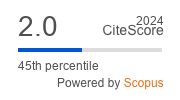Investigation on the future of work: the impact of innovative strategies in a post pandemic scenario
DOI:
https://doi.org/10.23726/cij.2022.1343Keywords:
work-life balance, shared-spaces, co-work, remote working, smart workingAbstract
In the following research work, an experiment of guided innovation is presented. The context is the Innovation for Change (I4C) program, in which a group of students, either PhDs or MBAs, are asked to solve a challenge provided by a stakeholder. The problem is “the future of work” in the context of a post pandemic scenario, with a focus on how to manage spaces remained empty due to remote working. The solution obtained is the consequence of a combination of brainstorming sessions, problem definition, benchmarking and interviewing stakeholders, experimental validation and prototyping. The outcome is a platform, B-Hub, which exploits empty locations to create a network of decentralised co-working spaces in which employees from every company can remotely work.
References
Barrero, J. M., Bloom, N. & Davis, S., 2020, 60 million fewer commuting hours per day: how Americans use time saved by working from home, Working Paper (Univ. Chicago Becker Friedman Institute for Economics), https://bfi.uchicago.edu/working-paper/60-million-fewer-commuting-hours-per-day-how-americans-use-time-saved-by-working-from-home/
Buffer, 2021, State of Remote Work, https://lp.buffer.com/2021-state-of-remote-work
Felstead A. and Henseke G., 2017, Assessing the growth of remote-working and its consequences for effort, well-being and work-life balance, New Technology, Work and Environment, 32(3), https://doi.org/10.1111/ntwe.12097
International Workplace Group & MindMetre Research, March 2019, Workplace Survey, https://assets.regus.com/pdfs/iwg-workplace-survey/iwg-workplace-survey-2019.pdf
Istituto Nazionale Previdenza Sociale (INPS), 2020, Rapporto Smart Working INPS, https://www.inps.it/docallegatiNP/Mig/Dati_analisi_bilanci/Attivita_ricerca/Studi_e_analisi/Rapporto_Smart_Working_Inps2020_n2-2021.pdf
Karspersky, 2021, Women in Tech Report, https://wit.kaspersky.com/,https://media.kasperskydaily.com/wpcontent/uploads/sites/85/2021/01/18101159/Kaspersky-Women-in-Tech-2021Report-V2-Final.pdf
McEwan, A.M., 2016, Smart working: Creating the next wave. CRC Press, ISBN: 1317054121, 9781317054122.
Office for National Statistics (ONS), 2014, Characteristics of Homeworkers, https://webarchive.nationalarchives.gov.uk/ukgwa/20160105160709/http:/www.ons.gov.uk/ons/dcp171776_365592.pdfh
Yang, L., Holtz, D., Jaffe, S. et al., 2022, The effects of remote work on collaboration among information workers, Nature Human Behaviour 6, pp.43–54, https://doi.org/10.1038/s41562-021-01196-4
World Economic Forum, The Future of Jobs Report, 2020, https://www.weforum.org/reports/the-future-of-jobs-report-2020
Downloads
Published
How to Cite
License
Copyright (c) 2022 Marco Puliti, Elena Di Giusto, Viola Papetti, Federica Montana

This work is licensed under a Creative Commons Attribution 4.0 International License.
Authors who publish with this journal agree to the following terms:
- Authors retain copyright and grant the journal right of first publication with the work simultaneously licensed under a Creative Commons Attribution License that allows others to share the work with an acknowledgement of the work's authorship and initial publication in this journal.
- Authors are able to enter into separate, additional contractual arrangements for the non-exclusive distribution of the journal's published version of the work (e.g., post it to an institutional repository or publish it in a book), with an acknowledgement of its initial publication in this journal.
- Authors are permitted and encouraged to post their work online (e.g., in institutional repositories or on their website) prior to and during the submission process, as it can lead to productive exchanges, as well as earlier and greater citation of published work (See The Effect of Open Access).


